
If you are a senior who wants to stay in your home, you’re not alone. A recent poll from the University of Michigan found that 88% of seniors want to stay in their homes as they age.
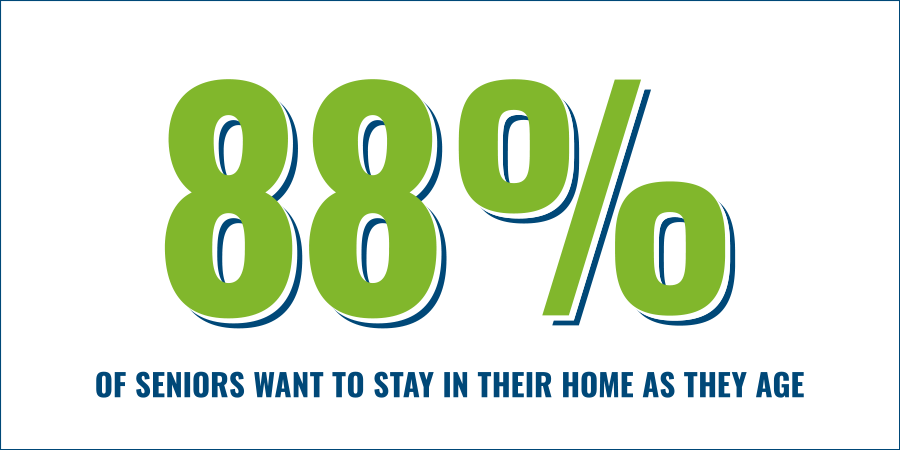
The popular decision to stay in your home as an older adult is sometimes called “staying in place” or “aging in place.” There are many reasons why you would choose to live independently, ranging from finances to relationships and personal preference.
If you are a senior who wants to live independently, we have good news. With the right information and support, you very well can! In this two-part series, we’ll share advice for seniors who want to live at home as they age.
This article is Part 1, and covers 4 tips focused on preparing yourself and your home to live independently as a senior:
- Know the benefits
- Define your values
- Maximize safety
- Ensure accessibility
Part 2 will focus on tips to stay connected with your community as you live at home.
We hope this series is a helpful resource for you. Please note that these articles are intended for informational purposes only and should not substitute medical advice. If you have health-related questions or concerns about living at home, we recommend you consult with your medical provider.

If you need home modifications, you’ve found the right team. Contact your local accessibility experts at Next Day Access to schedule a free in-home consultation. We’ll help you identify potential barriers to your safety and independence, along with solutions that meet your needs.
“Words can’t express how wonderful Next Day Access was for our family. It is not an easy time to see parents age and need assistance, but Next Day Access was patient, respectful, extremely responsive, and attentive. The product, customer appreciation and attention from this company is beyond 5 stars!”
Kelly, Ohio
1. Know the benefits of choosing to live independently at home compared with other senior housing options.

The first thing you can do when preparing to live independently is to learn the benefits compared with other housing options for seniors. Knowing this information might give you greater peace of mind about your decision to live independently. More importantly, staying informed will help you to prepare a safer, more supportive, and sustainable home for years to come.
Being able to live independently is good for your health.
For many people, living at home preserves a sense of independence. Independence involves the freedom to make decisions about your life. Your decisions can include big picture considerations like housing, medical care, and relationships, as well as smaller choices that meet your daily needs including food, hygiene, and recreation.
Your independence is about more than feeling free. It also involves your sense of agency: a belief that you are capable of influencing your circumstances. Most of us have spent our entire adult lives feeling free and capable. As we age, protecting our sense of independence may help us to navigate profound changes associated with this season of life.
Older adults may navigate several significant life stressors at once, including:
- Housing decisions
- Adjusting to life after retirement
- Financial stress
- Caregiving for a spouse or loved one
- Loss of friends who move or pass away
- Unexpected illness or injury
- Changes in mobility or functioning

Research shows that seniors who feel empowered have better outcomes in response to stress. Research published by The Journal on Aging and Human Development showed that seniors who responded to their challenges through positive reframing or problem-solving experienced better outcomes in health, relationships, and finances. By contrast, those who coped through avoidance or emotional discharge experience higher rates of depression, substance abuse, and distress.
“Research shows that seniors who feel empowered in their responses to stress experience better outcomes in health, relationships, and finances.”
Your sense of independence can be a powerful asset in navigating the stresses of older adulthood. While housing might be an important factor, make sure you also maintain good physical activity, nutrition, and regular medical care. By taking care of yourself, you’ll further improve your quality of life at home, not to mention your chances of living independently for as long as possible.
Choosing in-home care can save you money.

Whether or not you currently need caregiving support, you should understand the costs of care when living at home. In-home care is common, with AARP reporting that 1 in 4 care recipients live at home. The rate of in-home care recipients increases with age. At 65 years old, 27% of people receive support from informal and/or formal caregivers. The rate of caregiving support increases with age, with 54% of adults 85 years and older receiving paid support–and much higher rates of unpaid support at 90%.

The good news is that in-home care often costs less than other options. Depending on your location and level of care, in-home care from homemaker services or home health aides can cost significantly less than care at residential facilities. In fact, a recent survey from Genworth on the “Cost of Care” reports that the median cost of in-home care for seniors is about half the cost of nursing home facilities.
“The median cost of in-home care for seniors is about half the cost of nursing home facilities.”
Median annual costs for care vary based on your living situation.
If you need full-time in-home care, your costs may be comparable to assisted living facilities. Below is a list of median annual costs for care in various living situations for seniors.
- In-home care includes homemaker and home health aide services, with median annual costs for full-time services ranging from $59,488 to $61,776.
- Retirement communities include senior apartments and independent living communities that offer low levels of care, with a median annual cost of $30,624.*
- Community and assisted living includes Adult Day Health Care (ADC) and Assisted Living Facilities (ALF), with median annual costs ranging from $20,280* to $54,000.
- Nursing home facilities include varying levels of care in semi-private and private rooms, with median annual costs ranging from $94,900 to $108,405.
While senior living communities and Adult Day Health Care (ADC) appear lower in cost, it is important to remember that services are limited and additional at-home care coverage might significantly increase your cost of living.
To find more information about median costs of care in your state, check out this report from Genworth. Additionally, if you want to explore housing options beyond living at home in more detail, start by consulting the Senior Housing Options & Retirement Guide from SeniorLiving.org.
Being able to live independently can limit your risk of illness.
Since 2020, COVID-19 has raised public awareness about the increased health risks for seniors who live in residential care facilities. According to a study published in JAMA Network Open, nursing home residents were at a significantly higher risk of COVID-19 infection and mortality compared to seniors who lived in the community. The study found a mortality rate 13 times higher for seniors living in nursing homes compared with those who lived in their own homes.
Studies have also found that seniors who age in place face lower risks of infection beyond coronavirus. A study published in Clinical Infectious Diseases reports that older adults living in residential care facilities face an “increased risk of common community-acquired infections including pneumonia, UTI, prosthetic joint infection, and infected endovascular foreign bodies with bacteremia.”
Overall, these studies suggest that living at home may be associated with better health outcomes than residential care facilities. By staying in your home, you may have better control over your environment and activities–along with your risk of infection.

While living at home can support your independence, finances, and health, it is important to be proactive about safety modifications. The truth is, a single accident can undermine your ability to stay in your home–not to mention cause you a lot of pain and stress.
For fast, professional help, contact your local accessibility experts at Next Day Access. We’ll meet you for a free in-home consultation and make sure your home is ready to support the benefits of living independently.
“We contacted Next Day Access after suddenly needing to arrange for my parents to be able to have a ramp into their home and access throughout the house for a walker. They set up an appointment for a quote almost immediately, and had the ramp and other equipment in within a week from the quote. The ramp looks great and is very functional. The staff was very friendly and professional. The services are very reasonably priced. I liked working with a company that takes care of our veterans, too. I highly recommend them!”
Amy, Virginia
2. Define your standard of living and make choices based on your values and priorities.

The next step in preparing for living independently at home involves identifying your values and priorities. What is most important to you in the long-term?
- Autonomy
- Relationships with family and friends
- Keeping your current residence
- Affordability
- Access to medical care or other services
Your personal priorities might include one or more of the above–or something else entirely. Whatever your reasons for staying in place, you deserve a living arrangement that best supports your health and happiness.
It is important to make sure your choices align as closely as possible with what matters most to you. It can be tempting to focus on logistics first, especially if you are facing limitations on your budget, support system, or available services.
If you do not know how to answer these questions, don’t worry. For over 25 years, our team has worked with thousands of individuals in the midst of unexpected or uncertain circumstances. Contact your local accessibility experts at Next Day Access and let us help you.

3. Maximize safety to live independently in your home and prevent accidents before they happen.
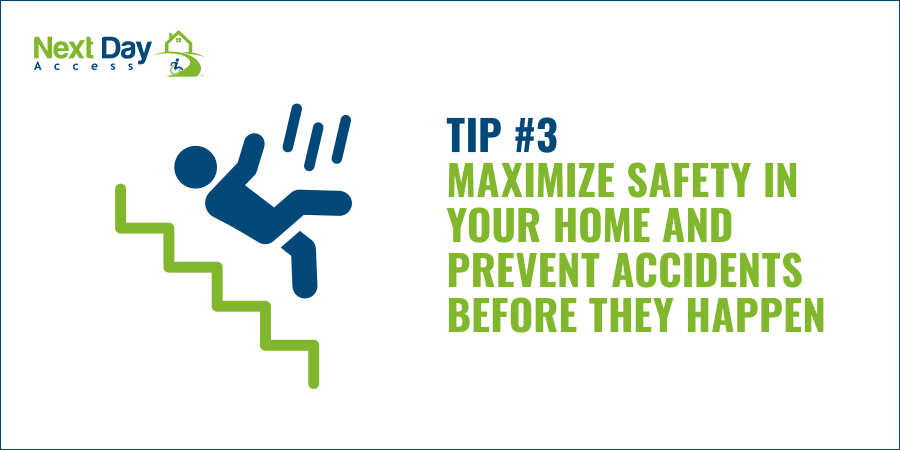
One of the most important steps you can take to maximize safety is to accommodate your changing needs by modifying your home. This includes making changes to high-risk areas such as bathrooms and staircases, where accidents are more likely to occur. Installing Barres d'appui, safety poles, and non-slip flooring in these areas can significantly reduce the risk of falls and other injuries.
For example, an article published by the American Journal of Occupational Therapy reports “strong evidence” that home modifications “improve function for people with a variety of health conditions…[and] reduce the rate and risk of falls among older adults.” A study published by The Journal of the Human Factors and Ergonomics Society found that the use of a grab bar when exiting the shower improved chances of recovery from a loss of balance by 75.8%.

Reducing fall risks is especially important for seniors. One-third of seniors who fall require hospitalization, with medical costs averaging $36,671.
Whether you self-assess your home safety needs or ask for professional help, make sure you pay attention to the following areas of your home:
- Bathroom slip-and-fall accidents
- Stairs, uneven surfaces, and cluttered or poorly lit areas
- Outdoor walkways impacted by ice or snow
If you are interested in a free in-home consultation, Nous contacter now or read on to learn about some of our most popular home safety solutions:
Grab bars and safety poles.
Our professionals can install grab bars and safety poles quickly and easily–often in a matter of hours. These products take up minimal space but offer a big boost to your stability and safety in the bathroom.
We commonly install grab bars and safety poles for use near the toilet, when stepping in and out of the bathtub or shower, and during bathing. You can choose from options designed to remain stationary, adjust and lock, or fold on a hinge.
Our grab bars and safety poles are made of high-quality materials like stainless steel and anti-microbial vinyl for hygiene and easy cleaning. If you want to match your existing bathroom hardware, you’ll find options with finishes like polished chrome, brushed chrome, matte black, and oil rubbed bronze.
Bathroom products.
In addition to grab bars and safety poles, we carry Produits de salle de bain like commode chairs, folding shower seats, bidets, and accessible wash basins. All of our bathroom products are ADA-compliant, meeting the highest standards for accessibility and safety.
Ready to schedule your free in-home consultation? Contact your local accessibility experts at Next Day Access. We’ll draw on our expertise and experience in helping you to identify safety risks and recommend solutions.

Smart Alert Tech Monitoring System.
For added peace of mind, consider purchasing Smart Alert Tech. This little piece of technology protects your privacy while making sure you are safe.
There are two simple options for Smart Alert Tech.
- Plug-in device: Simply plug in your Smart Alert Tech to any household electronic device that you use regularly. Some people choose a small device like their coffee maker, while others opt for something bigger like a stair lift.
- Sensor: Just mount your sensor in a room where you have a daily routine. Common choices include the bathroom or kitchen.
You can set an alarm for a specific time of day. For instance, you might set your alarm for 9am if you make coffee in the mornings. Friends or caregivers will receive alerts if your Smart Alert Tech notices you’ve missed your routine, or if there is a disruption to power in your home.
There are no subscriptions with Smart Alert Tech devices. After your one-time purchase, simply download the app, pair your device, and grant access to the people you choose.
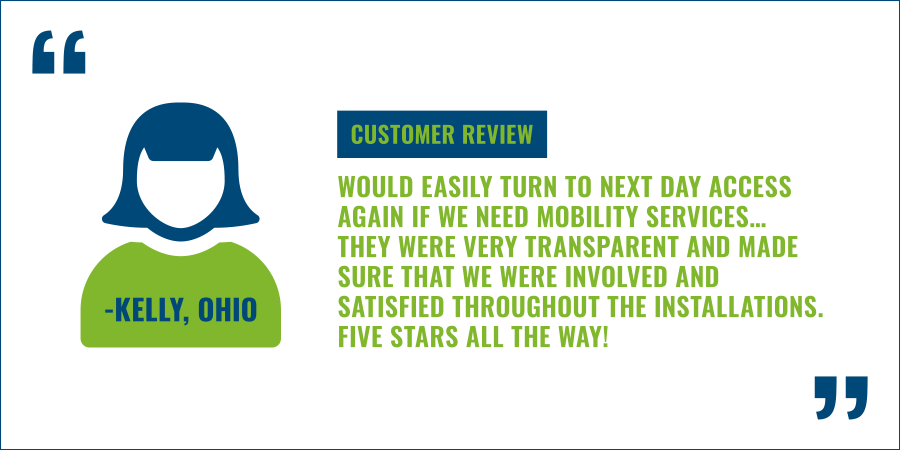
4. Review your home accessibility needs regularly.
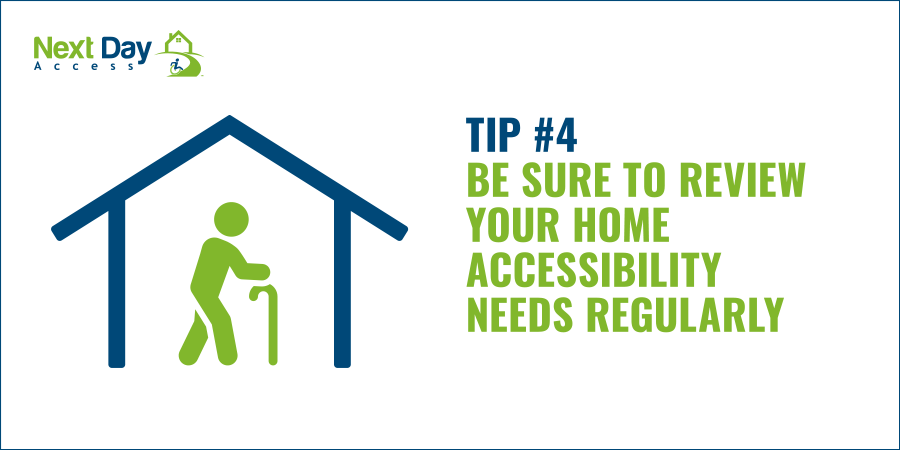
If you want to live independently at home as you age, maximizing accessibility is essential. Accessibility involves making the rooms in your home usable for you. Your accessibility needs may change over time, so make plans to review your accessibility needs regularly.
Contact your local accessibility experts at Next Day Access for professional help. We offer free in-home consultations with specific recommendations to create a safe, accessible home. You can also check out some of our favorite accessibility solutions below:
Stair lifts.
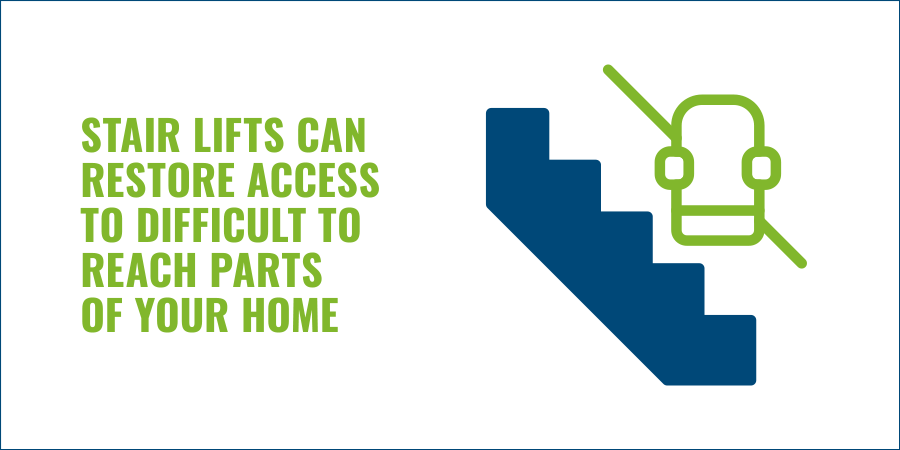
Monte-escaliers can restore access to upper story bedrooms, bathrooms, and other living spaces. This is especially important if your home is 1 of every 4 in the U.S. that lacks a bedroom or bathroom on the main floor. We can build custom stair lifts that fit your stairwell with a variety of designs and features based on your needs and preferences.
Portable showers.
Douches portatives are a great option for a variety of situations including:
- Temporary changes in mobility, such as during recovery or rehabilitation from surgery
- As an affordable alternative to major bathroom remodeling projects
- During travel when an accessible shower is not available
There is a range of sizes to choose from, including options large enough for wheelchairs and caregivers. Our portable showers are easy to set up and use. Just connect your shower to a sink faucet for hot water access, and direct wastewater tubing into a nearby drain like a sink, toilet, or shower.
When you’re finished, your portable shower can fold down to a size just slightly larger than an umbrella for easy storage in your closet or car.
Walk-in tubs.
Every home walk-in tub from Next Day Access contains the same quality materials and construction as those used in healthcare facilities. You can choose tubs with a variety features including:
- Doors that swing outwards or inwards
- Step-in or walk-through
- Ergonomic seating
- Wheelchair and lift accessibility
- Design for bariatric patients
- Built-in or freestanding
- Add-on accessories for hydrotherapy, aromatherapy, and chromatherapy
We also carry kits that allow you to convert an existing shower or tub for a fraction of the price.
Ready for a free in-home consultation? Contact your local accessibility experts at Next Day Access. We can help you clear barriers to accessibility so you can continue to live comfortably in your home.
“Next Day Access was awesome! I had a ramp to my specifications installed for my mothers house in a time period that exceeded my expectations. Quality product and quality company! I would highly recommend them.”
Mike, Iowa
If you want help to live independently, we’re here for you.
As local accessibility experts, our role is to help you have the best possible outcomes with the best possible experience. You can expect rock-solid customer service and unconditional support from your first phone call to final installation.
We’ve helped thousands of older adults adapt their homes to be able to live independently with respect to their budget, timeline, and goals. We’d be glad to help you, too. Nous contacter today to get started.
For more tips on senior living, check Part 2 of this series coming next month.





